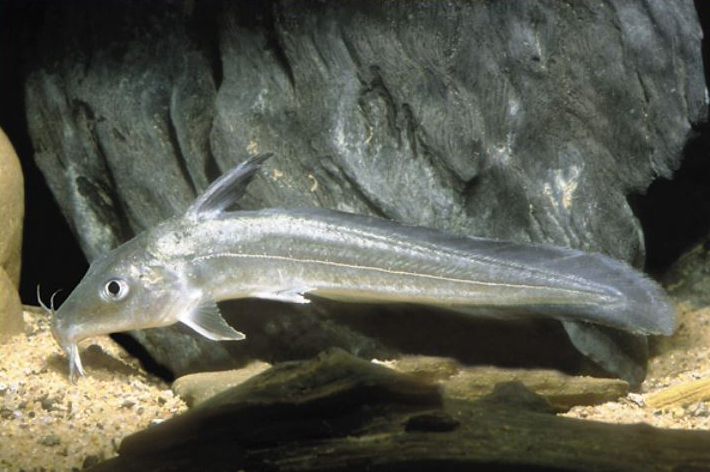Toothless Catfish, Anodontiglanis dahli Rendahl 1922

Toothless Catfish, Anodontiglanis dahli. Source: Freshwater Fish Group & Fish Health Unit, Murdoch University. License: All rights reserved
Video of Toothless Catfish in the Territory Wildlife Park, Northern Territory.
Toothless Catfish, Anodontiglanis dahli Rendahl 1922
More Info
|
Distribution |
Known only from the Fitzroy River, Western Australia, to Cape York, Queensland. Inhabits sandy areas around woody debris in clear, flowing larger rivers and streams, and flooded lagoons. |
|
Features |
Dorsal fin I, 6; Pectoral fin I, 11; Pelvic fin 12-13; Caudal-dorsal-anal fin 175-180; Gill rakers (first arch) 15-16; Vertebrae 52-54. Body elongate and tapering posteriorly; head large, broad, slightly flattened with a steep snout to dorsal profile; eye large; no teeth in mouth but some in the pharynx; 4 pairs of barbels around the mouth. Scales absent. Anterior dorsal fin small but relatively tall with 1 sharp spine and 6 soft rays; 2nd dorsal and anal fins confluent with caudal fin, originating just behind 1st dorsal and in line with pelvic fins; Caudodorsal fin base length more than half SL; pectoral fin with 1 sharp spine and 11 soft rays; adipose fin absent. |
|
Size |
To 40 cm, but commonly to 20 cm. |
|
Colour |
Mottled grey or brown overall with several vertical rows of pale dots along the sides. |
|
Feeding |
Feeds by thrusting its snout into the sandy bottom on aquatic insect larvae, detritus, molluscs and prawns. |
|
Biology |
Little is known of the breeding biology other that spawning occurs early in the wet season. |
|
Remarks |
Typically solitary. Sharp spines at the dorsal and pectoral fin origins are venomous. |
|
Etymology |
The species is named dahli in honour of Norwegian zoologist and explorer Knut Dahl (1871-1951), who collected the holotype. |
|
Species Citation |
Anodontiglanis dahli Rendahl 1922, Meddr. Zool. Mus. Kristiania 5: 169, figs 2-3. Type locality: Glencoe River, Northern Territory. |
|
Author |
Gomon, M.F. & Bray, D.J. 2018 |
|
Resources |
Toothless Catfish, Anodontiglanis dahli Rendahl 1922
References
Allen, G.R. 1982. Inland Fishes of Western Australia. Perth : Western Australian Museum 86 pp. 6 figs 20 pls.
Allen, G.R., Midgley, S.H. & Allen, M. 2002. Field Guide to the Freshwater Fishes of Australia. Perth : Western Australian Museum 394 pp.
Allen, G.R. & Swainston, R. 1988. The Marine Fishes of North-Western Australia. A field guide for anglers and divers. Perth, WA : Western Australian Museum vi 201 pp., 70 pls.
Burgess, W.E. 1989. An Atlas of Freshwater and Marine Catfishes — a preliminary survey of the Siluriformes. Neptune City, New Jersey : T.F.H. Publications 783 pp.
Larson, H.K. & Martin, K.C. 1990. Freshwater Fishes of the Northern Territory. Northern Territory Museum of Arts and Sciences Handbook Series Number 1. Darwin : Northern Territory Museum of Arts and Sciences 102 pp. 73 figs.
Leggett, R. & Merrick, J.R. 1987. Australian Native Fishes for Aquariums. Artarmon : J.R. Merrick Publications 241 pp. 142 figs.
Merrick, J.R. & Schmida, G.E. 1984. Australian Freshwater Fishes Biology and Management. Sydney : J.R. Merrick 409 pp. figs 280 col. figs.
Morgan, D.L., Allen, G.R., Pusey, B.J. & Burrows, D.W. 2011. A review of the freshwater fishes of the Kimberley region of Western Australia. Zootaxa 2816: 1-64.
Morgan, D.L., Allen, M.G., Bedford, P. & Horstman, M. 2004. Fish fauna of the Fitzroy River in the Kimberley region of Western Australia – including the Bunuba, Gooniyandi, Ngarinyin, Nyikina and Walmajarii Aboriginal names. Records of the Western Australian Museum 22: 147-161.
Rendahl, H. 1922. A contribution to the ichthyology of north-west Australia. Meddelelser fra det Zoologiske Museum. Kristiania 5: 163-197 figs 1-6
Unmack, P.J. 2001. Biogeography of Australian freshwater fishes. Journal of Biogeography 28: 1053-1089.



